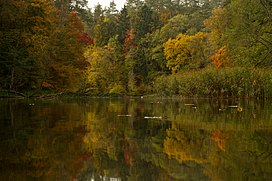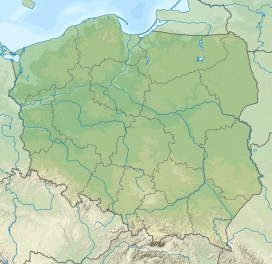Puszcza Piska Forest or the Pisz Forest (German: Johannisburger Heide) is the largest forest complex of the Masuria region in northern Poland, adjacent to the Masurian Landscape Park, and the Masurian Lowlands. Formerly known as the Jańsborska wilderness, Puszcza Piska bears the name of the Pisa river bordering the Forest along its west bank.[1][2]
| Puszcza Piska | |
|---|---|
 Krutynia River flowing through the forest | |
| Map | |
| Geography | |
| Location | Poland |
| Coordinates | 53°36′44″N 21°30′59″E / 53.6121°N 21.5163°E |
| Ecology | |
| Dominant tree species | pine, spruce |
The Pisz Forest consists of a unique combination of coniferous trees, lakes and rivers.[3] Its total area is c.100,000 ha. It covers the communes of Mikołajki, Mrągowo, Piecki, Sorkwity, Biskupiec, Biała Piska, Orzysz, Pisz, Ruciane-Nida, Dźwierzuty, Rozogi, Szczytno, Świętajno, Kolno, Turośl and Łyse. Within its borders are a number of lakes, designated as nature reserves. Among them: Bełdany, Nidzkie, Jegocin, Warnołty nature reserve, Mokre, and the largest lake in Poland called Śniardwy. Two principal rivers flow through the area – Krutynia and Pisa, as well as many smaller tributaries and streams.[3][4]
Flora
editThe southern part of the forest grows on sands and lowland bogs. The soil is being drained by the Narew tributaries, including Pisa and Szkwa, as well as many lakes. The northern part of the complex borders on Masurian Lake District known in Polish as Kraina Wielkich Jezior. The Piska Forest consists of pine and spruce groves with the mixture of birch, aspen, maple, alder and oak growing on sandy soil mainly at the southern end of the forest. The best known among the local trees is the "Masurian pine" covering eastern edges of the Mokre lake. It reaches the height of 40 m and the age of 200 years.[3]
Fauna
editPuszcza Piska is a bird sanctuary on a European scale, featuring eleven nature reserves within its own Masurian Landscape Park (Mazurski Park Krajobrazowy) established in 1977 with the total area of 53,600 ha. The most valuable reserve is located at the Łuknajno Lake near the town of Mikołajki – a Ramsar site designated by UNESCO as a biosphere reserve.[5] It is the home of the mute swan (pictured), native to temperate regions of Europe and western Asia, in time of moult arriving in numbers reaching up to 2,000 birds.[6][7][8] Many species of wild animals live in the forest, among them: deer, elk, moose, wild boar, hare, fox and recently reintroduced lynx. On wetlands, most saturated with water, beaver lodges can be found. The symbol of the park is a white stork with nests scattered over many local villages.[4][5]
Gallery
edit-
Forest near Stare Kiełbonki
-
Śniardwy Lake at the Pisz Forest near Ruciane-Nida
-
Nature reserve Królewska Sosna
-
Nature reserve Strzałowo
-
Zdróżno Lake
See also
editReferences
edit- ^ "Forests in Western Poland". Polish Forests. PolandPoland.com. 2004. Retrieved 30 September 2010.
- ^ "Experience Poland: Flora" (webpage). Ministry of Foreign Affairs, Republic of Poland. 2008. Retrieved 30 September 2010.
- ^ a b c Salter, Mark; Bousfield, Jonathan (2002). Rough guide to Poland (book). London, England: Rough Guides. pp. 249–250. ISBN 1-85828-849-5. Retrieved 30 September 2010.
- ^ a b "Warminsko-Mazurski Voivodship and Region" (webpage). Regions of Poland. Ministry of Foreign Affairs, Republic of Poland. 2010. Retrieved 30 September 2010.
- ^ a b Mazurski Park Krajobrazowy, Poland (2005). "Łuknajno Lake: UNESCO biosphere reserve description" (webpage). Biosphere Reserve Information, Poland. UNESCO, United Nations Educational, Scientific and Cultural Organization. Retrieved 30 September 2010.
- ^ Tomiałojć, Ludwik; Stawarczyk, Tadeusz (2003). Awifauna Polski. Rozmieszczenie, liczebność i zmiany (book) (in Polish). Wrocław, Poland: PTPP "pro Natura". pp. 295–297. ISBN 83-919626-1-X.
- ^ Snow, D. W.; Perrins, C. M. (1998). The Birds of the Western Palearctic. Oxford, England: Oxford University Press. ISBN 0-19-854099-X.
- ^ Madge, S.; Burn, H. (1987). Wildfowl: An Identification Guide to the Ducks, Geese and Swans of the World (book). London, England: A & C Black. ISBN 0-7470-2201-1.
External links
edit- Paulina Garbalińska, Jarosław Skłodowski, "Body size differentiation in selected carabid species inhabiting Puszcza Piska forest stands disturbed by the hurricane." Department of Forest Protection and Ecology, Warsaw University of Life Sciences
- (in Polish) "Kraina Mazursko – Podlaska Charakterystyka przyrodniczo-leśna," Regionalna Dyrekcja Lasów Państwowych, Białystok
